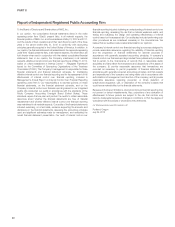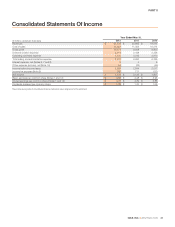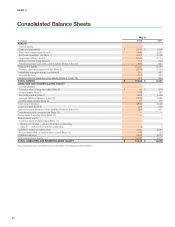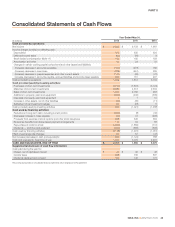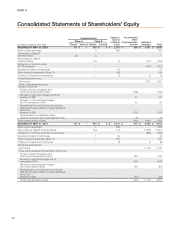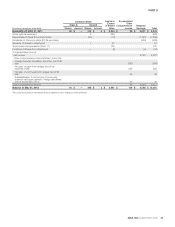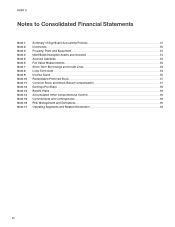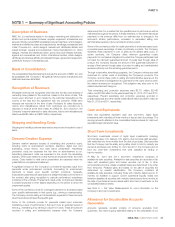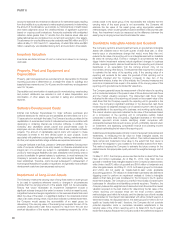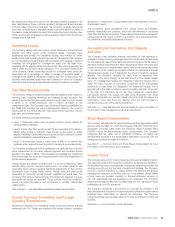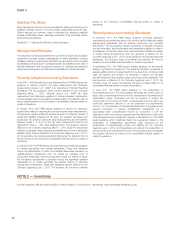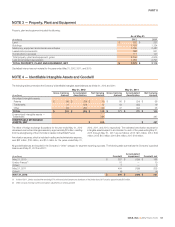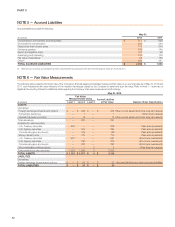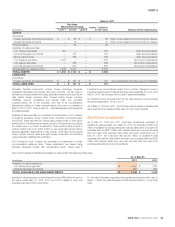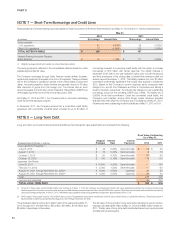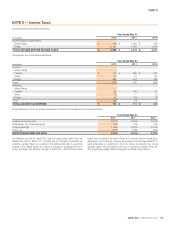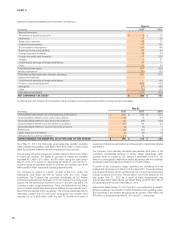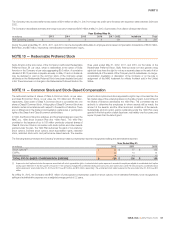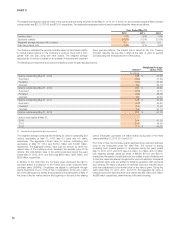Nike 2012 Annual Report Download - page 50
Download and view the complete annual report
Please find page 50 of the 2012 Nike annual report below. You can navigate through the pages in the report by either clicking on the pages listed below, or by using the keyword search tool below to find specific information within the annual report.
PART II
Earnings Per Share
Basic earnings per common share is calculated by dividing net income by the
weighted average number of common shares outstanding during the year.
Diluted earnings per common share is calculated by adjusting weighted
average outstanding shares, assuming conversion of all potentially dilutive
stock options and awards.
See Note 12 — Earnings Per Share for further discussion.
Management Estimates
The preparation of financial statements in conformity with generally accepted
accounting principles requires management to make estimates, including
estimates relating to assumptions that affect the reported amounts of assets
and liabilities and disclosure of contingent assets and liabilities at the date of
financial statements and the reported amounts of revenues and expenses
during the reporting period. Actual results could differ from these estimates.
Recently Adopted Accounting Standards
In April 2011, the Financial Accounting Standards Board (“FASB”) issued new
guidance to achieve common fair value measurement and disclosure
requirements between U.S. GAAP and International Financial Reporting
Standards. This new guidance, which became effective for the Company
beginning March 1, 2012, amends current U.S. GAAP fair value
measurement and disclosure guidance to include increased transparency
around valuation inputs and investment categorization. The adoption did not
have a material impact on the Company’s consolidated financial position or
results of operations.
In January 2010, the FASB issued guidance to amend the disclosure
requirements related to recurring and nonrecurring fair value measurements.
The guidance requires additional disclosures about the different classes of
assets and liabilities measured at fair value, the valuation techniques and
inputs used, the activity in Level 3 fair value measurements, and the transfers
between Levels 1, 2, and 3 of the fair value measurement hierarchy (as
described in Note 6. —Fair Value Measurements). This guidance became
effective for the Company beginning March 1, 2010, except for disclosures
relating to purchases, sales, issuances and settlements of Level 3 assets and
liabilities, which became effective for the Company beginning June 1, 2011.
As this guidance only requires expanded disclosures, the adoption did not
have an impact on the Company’s consolidated financial position or results of
operations.
In October 2009, the FASB issued new standards that revised the guidance
for revenue recognition with multiple deliverables. These new standards
impact the determination of when the individual deliverables included in a
multiple-element arrangement may be treated as separate units of
accounting. Additionally, these new standards modify the manner in which
the transaction consideration is allocated across the separately identified
deliverables by no longer permitting the residual method of allocating
arrangement consideration. These new standards became effective for the
Company beginning June 1, 2011. The adoption did not have a material
impact on the Company’s consolidated financial position or results of
operations.
Recently Issued Accounting Standards
In December 2011, the FASB issued guidance enhancing disclosure
requirements surrounding the nature of an entity’s right to offset and related
arrangements associated with its financial instruments and derivative
instruments. This new guidance requires companies to disclose both gross
and net information about instruments and transactions eligible for offset in
the statement of financial position and instruments and transactions subject
to master netting arrangements. This new guidance is effective for the
Company beginning June 1, 2013. As this guidance only requires expanded
disclosures, the Company does not anticipate the adoption will have an
impact on its consolidated financial position or results of operations.
In September 2011, the FASB issued updated guidance on the periodic
testing of goodwill for impairment. This guidance will allow companies to
assess qualitative factors to determine if it is more-likely-than-not that goodwill
might be impaired and whether it is necessary to perform the two-step
goodwill impairment test required under current accounting standards. This
new guidance is effective for the Company beginning June 1, 2012. The
Company does not expect the adoption will have a material effect on its
consolidated financial position or results of operations.
In June 2011, the FASB issued guidance on the presentation of
comprehensive income. This new guidance eliminates the current option to
report other comprehensive income and its components in the statement of
shareholders’ equity. Companies will now be required to present the
components of net income and other comprehensive income in either one
continuous statement, referred to as the statement of comprehensive
income, or in two separate, but consecutive statements. This guidance also
required companies to present reclassification adjustments out of
accumulated other comprehensive income by component in both the
statement in which net income is presented and the statement in which other
comprehensive income is presented. However, in December 2011, the FASB
issued guidance which indefinitely defers the requirement related to the
presentation of reclassification adjustments. Both issuances on the
presentation of comprehensive income are effective for the Company
beginning June 1, 2012. As this guidance only amends the presentation of
the components of comprehensive income, the Company does not anticipate
the adoption will have an impact on its consolidated financial position or
results of operations.
NOTE 2 — Inventories
Inventory balances of $3,350 million and $2,715 million at May 31, 2012 and 2011, respectively, were substantially all finished goods.
50


